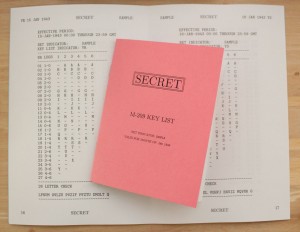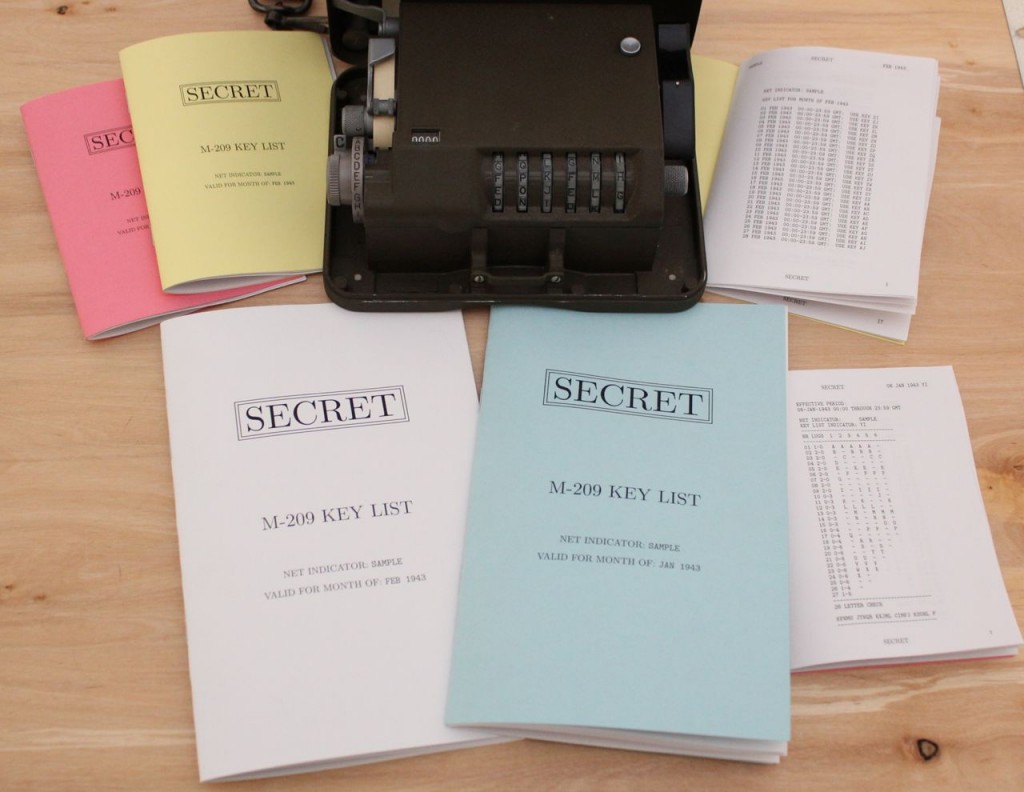I’ve just released version 2013-04-28a of my command-line M-209 simulator. The major addition to this release is a new Python script which generates key lists with daily scheduled key changes. The generated key list collections include 365-366 plain-text key files which may be read, printed or loaded into my simulator, and plain text key lists for each month which may be viewed or printed. Also, if TeX typesetting software and some other related utilities are available, various PDF key lists will be generated for on-screen viewing or printing into either small or large booklets. Please note that I’ve changed the version numbering from the old major.minor format to a date-based format.
I’ve never seen examples of real WW-2 era key lists, so I’ve come up with my own interpretation of what they might have looked like. I’ve also taken some creative license by adding an additional indicator to the normal M-209 message format, which I call the “Net Indicator”. Just for good measure, I also added a letter group count. The new format would look like this 33-group example with a net indicator of “SAMPLE”:
SAMPLE GR 33 KKETJ RNOYL YAOFG MRVMF VNAXD UWDAR RIRBZ NARKN MOJFN NQSOY IGIOC RWTNA RBSBU HVVKO NEHTG RGLHL FIAXX YFOYU EKSAE FPAMG QJSFJ OGRLP SWLPF IACGD WBWAJ OYZAF JKTNZ SGSBL KQUCW QFCFQ SKLCX KKETJ RNOYL
My idea of adding this net indicator was motivated by the desire to create more “lifelike” key lists for M-209 enthusiasts to use, without causing confusion when collectors inevitably publish their own key lists with conflicting key lists indicators. As long as each publisher picks their own unique net indicator, all will be well.
The key list generator creates a directory tree containing:
- A top-level README.txt file describing what’s in the tree.
- A subdirectory for each month, containing:
- A subdirectory with individual key files for each day of the month.
- A plain text key list.
- A PDF key list optimized for on-screen viewing.
- A PDF key list optimized for printing two-sided to create a 5.5″ x 8.5″ booklet.
- A PDF key list optimized for printing two sided to create two copies of a 4.25″ x 5.5″ booklet.
- The above printable PDFs burst apart for easier printing on single-sided printers.
The formatting of the print-optimized PDFs isn’t cast in stone yet, so it may change in the near future based on feedback from users. I’ve printed up some samples with various colors of card stock covers, which I’ll show to a few crypto enthusiasts at the upcoming annual MRCG meet in San Luis Obispo, CA.
I like the small pocket-sized form factor, but folks who have trouble reading small type may prefer the larger booklet size. I’m looking for feedback on the formatting, preferred cover color, etc.
Here are some examples of files included in a key list collection:
[attachments size=medium fields=”title,description,size,type” titletag=”” target=1 docid=”6047,6043,6046,6045,6044,6063″]
The latest version of my simulator (even pre-release work-in-progress) is always available on GitLab. This particular release can be downloaded here:
Advanced users who wish to download the very latest version (including not-yet-released work-in-progress) can clone the git repository:
git clone git@gitlab.com:NF6X_Crypto/hagelin.git

